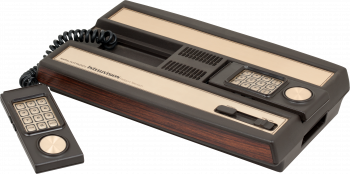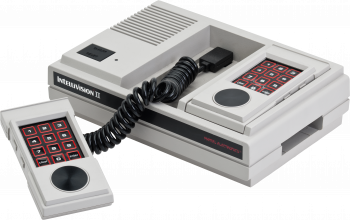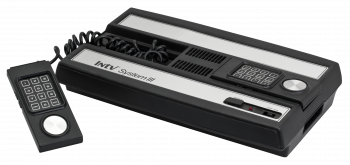Intellivision:Intellivision Model Differences
Several different models of the Intellivision exist, with most being a cosmetic variation of the original design.
Mattel Intellivision (1979-1983)
The original Intellivision console was initially released to a limited test market in 1979 and received a national release the following year. This is perhaps the most common version of the console and was sold until late 1982 in North America and 1983 in PAL regions. On the top of the console, which is molded in dark brown plastic, are two gold-colored aluminum faceplates, the lower of which has the power switch and reset button. Dominating the top are the two controllers, which are hardwired to the console and stowed in two compartments. At the front and rear edges are woodgrain appliques, a typical styling touch of the era. Also at the rear are the RF out and hardwired power cord, which can be pushed inside the console to reduce cable clutter. Cartridges are inserted into a slot on the right edge, which has an extremely tight fit.
This was also the only version of the Intellivision released in PAL regions, with French Intellivision consoles having a hardwired SCART cable carrying RGB output instead of RF.
Internally, the Intellivision has a fairly tidy layout, with the motherboard taking up much of the right side and the power supply on the left. The motherboard is encased in extensive RF shielding which is soldered to the board, making repairs and modifications tedious. In addition, the ribbon cable connecting the power supply to the motherboard is notorious for becoming brittle with age and can crumble apart. Great care must be taken during disassembly as a result.
GTE/Sylvania Intellivision (1979-1980)
A very minor cosmetic variation with the only differences from the Mattel version being silver-colored faceplates with the GTE and Sylvania logos on the lower plate. GTE/Sylvania manufactured early Intellivision consoles and performed initial testing of the console for Mattel, and so were allowed to sell their own variant of the console. Much like Mattel, Sylvania performed a limited test market in late 1979 followed by a nationwide release in 1980.
Sears Super Video Arcade (1981)
Like with Mattel's competitor Atari, Sears also sold their own version of the Intellivision, introducing it as the Super Video Arcade in 1981. Although mostly internally identical to the original Intellivision (the bottom half is completely identical), Sears opted to make both cosmetic and functional changes to the design. The top half is molded in cream-colored plastic with a burled woodgrain applique on the front edge. Both the power switch and reset button are much larger and are set in a recessed area with woodgrain trim. At the rear is a ribbed section painted in dark brown.
Perhaps the most dramatic change with the Super Video Arcade over the Mattel console is that Sears opted to have removable controllers, which use DE-9 connectors similar to those on the Atari 2600 (but are *not* compatible in any way). This makes the Super Video Arcade easier to deal with as 9-pin controller extension cables can be used for extra length, and faulty controllers can be easily removed for repair or replacement. The controllers themselves are identical to their Mattel equivalents, but are molded in the same color plastic as the console and have straight cables instead of coiled ones.
Radio Shack Tandyvision One (1982)
In 1982, Radio Shack sold a version of the Intellivision known as the Tandyvision One. Like the GTE/Sylvania console before it, it is nothing more than a standard Intellivision with different faceplates. In this case, both faceplates are woodgrain appliques instead of having a metallic finish.
Bandai Intellivision (1982)
The Intellivision received a limited release in Japan by toy company Bandai in 1982, and it is almost completely identical to its American counterpart save for the addition of the Bandai name on the upper faceplate and an RF modulator tuned for Japanese channels 1 and 2.
Intellivision II (1983)
As the Intellivision's popularity grew, Mattel decided to replace the original console with a cost-reduced, smaller version known as the Intellivision II early in 1983. This console is about 3/4ths the size of the original, largely made possible by replacing the internal power supply with an AC adapter brick. Both the power switch and reset button were consolidated into a single button, which resets the console with a short tap and shuts it off by being held down for about two seconds. Mattel also took the opportunity to update the Intellivision's EXEC program (BIOS) in order to lock out unauthorized games, and most games published by Coleco will not boot on an Intellivision II for this reason. The Intellivision II is also the only console compatible with the System Changer add-on, which allows Intellivision II owners to play Atari 2600 games. All other consoles must be modified for this accessory to work. In sharp contrast with the original, there is no RF shielding at all inside the console to impede modifications or repairs.
Both controllers were also completely redesigned, although with major concessions made in terms of player comfort. The side action buttons were switched from rubber to hard plastic and feature almost no tactile feel, and the keypad was also changed to an arguably inferior design with no tactile feedback at all. Thankfully, both controllers are removable and can be swapped with those from a Sears Super Video Arcade, although they cannot be stowed in the console due to the controller plugs sticking up inside the compartments.
Two cosmetic variations of the Intellivision II exist, one has sharp corners with a red stripe around the center of the console, and the other has slightly rounded corners without the red trim. The latter variant was the initial release of the system, and the former was released at the same time as the Entertainment Computer System (ECS) add-on and System Changer, which also have sharp corners with a red stripe.
INTV System III/Super Pro System (1986-1990)
After Mattel's exit from the video game market in 1984, a new company known as INTV Corporation (initially named Intellivision, Inc.) purchased the rights to the Intellivision IP as well as the rights to manufacture new games and consoles. The first of these new Intellivision consoles was the INTV System III, released in 1986.
Because INTV possessed a large stock of replacement parts from Mattel and due to the original Intellivision using more off-the-shelf components, the System III is actually based on the original console with only minor cosmetic changes. The system was now molded in black plastic without the woodgrain trim and both faceplates were silver instead of gold. INTV also added a red power LED between the power switch and reset button, something which was lacking on the original. The controllers are also mostly identical to their Mattel counterparts aside from the black and silver color scheme, although the keypads are more like those on the Intellivision II which are non-tactile. The System III does not have the Intellivision II's EXEC program and so all Intellivision games are compatible.
In 1988, INTV released the Super Pro System, which was identical to the System III save for the name, as it tied into INTV's "Super Pro" range of sports games (which themselves were reworked versions of games originally released by Mattel).



